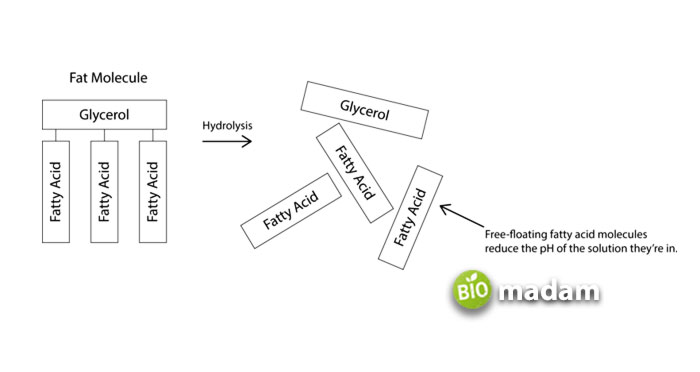Lipids were previously not much discovered, so scientists were not fully aware of their significance and importance. The ancient concept for lipids was that it only helps store energy or assist in building animal cell membranes. But these substances are a lot more than that! Researchers are still working, but up till now, it is stated that lipids contribute widely to the biological roles of a body. They range from transferring signals intracellularly to hormone regulation to much more.
What are Lipids?

These are the complex organic compounds, holding importance, and are crucial for living bodies containing hydrocarbons. Lipids generally consist of fats and oils, which serve as the integral elements for the structure and functioning of a body. The primary roles of lipids in a body are structuring a cell membrane, handling the signaling of molecules, and storing energy. All these are fulfilled if lipids include significant hydrocarbon components, such as carbon, hydrogen, and oxygen.
Examples of Lipids
Out of numerous lipid examples, most are saturated and unsaturated fats, such as oils, waxes, and essential vitamins (vitamin A, D, E, and K).
What are Lipids Made of?

All lipids are essential triglycerides, composed of fatty acids and alcoholic glycerol. We can add more compounds to this general structure if we want diversity in lipids for enhanced functioning. So far, almost 10,000 lipids came into existence that combines with other essential proteins or carbohydrates to process.
Comprehend the Functions of Lipids
Lipids are vital substances for any living entity to survive, covering a wide range of biological functions. Let us explore them one by one in the context of some relevant and noteworthy examples where applicable.
As Chemical Messengers
All multicellular living bodies send signals from one portion to another through chemical messengers. Lipids play a crucial role here by being a fantastic source of signaling. These are small, insoluble in water molecules that combine with the receptor site to send signals. Such lipids remain in their esterified condition to penetrate the cell membrane and carry signals to particular cells. Lipids stay inactive and are only activated at the site of action and through the proper receptor.
Helps in Storing Energy
It is far the oldest role, as experts say lipids help store energy in the body. An animal eating in excess can save the food for future use only with the help of lipids. This food is stored in the form of fat molecules. We, as human beings, have a different lifestyle where we cannot eat every time we feel hungry. That is why nature sets a mechanism through which fat molecules are capable of storing enough energy.

On the contrary, we know that plants use carbohydrates for energy storage and these substances are less efficient than lipids. The reason behind this, is plants are immobile, not need enough energy.
Role in Insulation
You must have commonly heard a question, “Are lipids hydrophobic?” And since, these are actually hydrophobic in nature or insoluble in water, they serve as an insulating source to both plants and animals from the environment. For example, in plants, the outer cuticle layer of the plant leaves secretes wax to perform its functions. Besides in different leaves, this layer also exists in the plant’s young shoots and other aerial parts. This waxy layer not only cleans the tissue from the point of secretion but also prevents water loss, secures photosynthetic cells, and insulates against heat and cold.
Similarly, discussing the insulation of animals through fats, the best example is marine mammals. They have an insulating fat layer present under the skin of all marine mammals, e.g., walruses, seals, and whales known as blubber. The bubbler provides thermal insulation as well as buoyancy to mammals.
Helps Prevent Heart Diseases
Lipids have a sub-type called fatty acids that may be saturated or unsaturated with further classifications. Omega 3-fatty acids are polyunsaturated fatty acids, with 18-22 carbon atoms that reduce heart diseases. Moreover, this complex structure has a double bond at every third position from its methyl terminal. A human body cannot synthesize it naturally, so one should take it into the diet to prevent heart ailments.

An essential function of Omega 3-fatty acid in the body is the reduction of body inflammation. This function has significant consequences for various heart diseases and strokes as inflammation is significant for blood vessels’ damage and heart anomalies. Besides, other functions of omega 3-fatty acids include:
- Reduction in depression and anxiety,
- Vision, brain and heart health improvement,
- Fights inflammation and autoimmune diseases,
- Improves mental disorders and age-related memory declines,
- Reduces asthma and fatty liver diseases,
- It may help fight cancer, cyst, or tumor, to improve joint and bone health
Used in Cholesterol Formation

Cholesterol is a sterol molecule, typically a type of lipid which exists in cell membranes. It has primary functioning in the blood, freely floating as plasma lipoproteins. It means these are the combined structure of lipids and proteins that helps it travel in an aqueous environment to move in the body. Cholesterol is further divided into:
- Chylomicrons (CM)
- Very Low-Density Lipoproteins (VLDL)
- Low-Density Lipoproteins (LDL)
- High-Density Lipoproteins (HDL)
A living body can maintain membrane fluidity through cholesterols, particularly phospholipids. Moreover, these compounds are the prototype of vitamin D, steroidal hormones, and bile acids.
Role in Healthy Brain Functioning

A lack of adequate dietary and nutritional intake of lipids can significantly affect the brain’s health and function. That is because lipids play a delicate structural and functional role in neurons. All neurons contain an insulating lipid layer that works for the fast transmission of signals across the brain. The sheer maintenance of this fundamental phenomenon speaks for the importance of lipids in the maintenance of appropriate brain health.
Forms the Lung Surfactants
Lung surfactants, also known as pulmonary surfactants, are lipoprotein complexes, that form a layer on the surface of lung cells (alveolar cells). This surfactant layer functions to decrease lung surface tension and thus helps in increased lung compliance (an ability of a lung to expand or stretch). A lung surfactant primarily contains lipoprotein complexes, called dipalmitoylphosphatidylcholine (DPPC). Since it constitutes 80 – 90% weight of lung surfactant, it holds an important position for normal pulmonary function.

Most people are unaware of how DPPC helps in the enlargement of both, right and left, lungs. The hydrocarbon chains of DPPC molecules are saturated, thus tending to extend without bending. Moreover, the close packing of DPPC molecules and their orientation within the layer prevents the lungs from collapsing when exhaling air.
Helps Regulate the Calcium Metabolism
Vitamin D is a lipid hormone that is also a sterol derivative. It forms in animal skin via UV light from the sun. Vitamin D facilitates the uptake of dietary calcium via its absorption through the small intestine in its active state. Thus, increasing the resultant deposition of calcium in bones and teeth.
Being insoluble in water, this lipid hormone is stored in the fatty tissues inside the body. But, excessive amounts or intake of this vitamin for a more extended period can result in a disease known as vitamin D intoxication. Consequently, the blood serum calcium levels increase, triggering the calcification of soft tissues and kidney stones. At last, they result in kidney failure and eventually death.
Are Lipids Significant for a Living Body?
It is justifiably concluded that lipids hold a prime position in living organisms through their various essential functions. Still, excessive individual types of lipids can also lead to serious health consequences. Therefore, one needs to have a balanced, well-informed aptitude when adding lipids to their healthy meal plan not to intoxicate oneself from an overdose.

Jeannie has achieved her Master’s degree in science and technology and is further pursuing a Ph.D. She desires to provide you the validated knowledge about science, technology, and the environment through writing articles.

